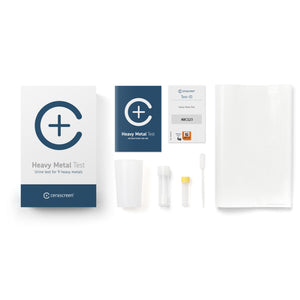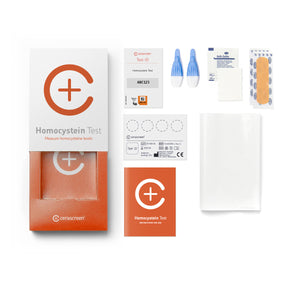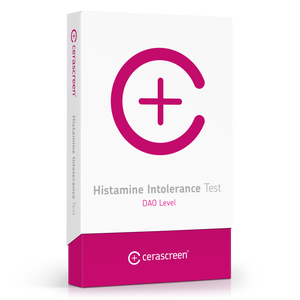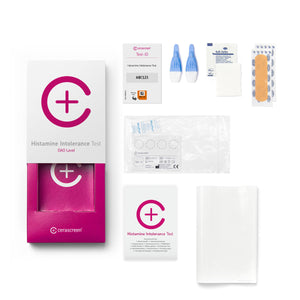product_id = 9826222407variant_id = 38260135623template_name =

Lactose Intolerance Test
About the test
Lactose intolerance is the most common food intolerance worldwide - in large parts of Africa and Asia, the majority of people cannot tolerate lactose. In the United Kingdom, studies show that eight per cent of the population is affected. They suffer from symptoms such as abdominal pain, nausea, flatulence and diarrhea when they eat foods containing lactose.
With the cerascreen® Lactose Intolerance Test, you can determine the concentration of hydrogen and methane in your breath after consuming a lactose solution. Your values from the test are then able to provide you with an indication of a possible lactose intolerance.
Lactose Intolerance Test
- Take your sample at home - conveniently and discreetly
- Receive a state-of-the-art laboratory analysis
- Get a comprehensive results report
- Benefit from specific recommendations on how to live with lactose intolerance
- Receive the result within a few days after your sample’s arrival at the laboratory
What is lactose intolerance?
Lactose intolerance is an intolerance to disaccharide (polysaccharide) lactose or milk sugar. This consists respectively of a molecule of the monosaccharides glucose and galactose. Lactose has to be split into its monosaccharides for processing in the small intestine. The enzyme lactase, which is found in the villi of the small intestine, is responsible for this function. Only the monosaccharides can be metabolised by the sodium dependent SGLT1-transporter in the various sections of the intestine. Depending on the residual activity of the enzyme lactase, the degree of severity of lactose intolerance can differ greatly and the symptoms vary correspondingly. If the milk sugar is not or only partly split by the digestive enzyme lactase, and if larger amounts of milk sugar reach the lower sections of the intestine populated by bacteria, the lactose then feeds the bacteria. This creates large amounts of gases and fatty acids, which leads to complaints. Lactose intolerance should not be confused with a milk protein allergy. In contrast to an allergy, in which the immune system is involved and the corresponding antibodies are formed, lactose intolerance arises from a deficit or insufficiency of enzyme production without the involvement of the immune system. Approximately 15-20 % of the total population in Great Britain is affected by lactose intolerance. There is a North-South divide in Europe.
Which complaints can occur from a lactose intolerance?
If the milk sugar is not or only insufficiently split by the digestive enzyme lactase in the small intestine, larger amounts of the undivided lactose reach the lower sections of the intestine populated by bacteria and ferment there. Large amounts of hydrogen, methane, carbon dioxide and short-chain fatty acids are subsequently created, which leads to complaints. Neither the hydrogen nor methane but rather the formation of carbon dioxide and fats are what cause symptoms. The large amount of carbon dioxide causes flatulence. This can be eliminated via the large intestine. In contrast, in the small intestine the gas is transported through the intestinal wall, passes to the blood and is expelled through the lungs. This procedure is extremely uncomfortable and can also cause bad breath. The fatty acids carry water into the intestine, which causes a dilution of the stool and leads to diarrhoea. Bowel sounds are caused by the increase in intestinal movement. The change in consistency of the stool is explained by the increase in proportion of fatty acids, so-called fatty stools, or the increased inclusion of gases. Other symptoms are possible in connection with lactose intolerance. These include heartburn and fatigue as well as migraine headaches.
Benefits of the Lactose Intolerance Test
Lactose is found in more foods than you think. Of course, a glass of milk has a lot of lactose, as do some dairy products such as cream and cream cheese. But lactose is also found in ready-made products, sweets, baked goods and sausages, among other things.
There are many lactose-free products on the market, which are often expensive and offer no health benefits for people without lactose intolerance. So before you change your diet, it is worth checking whether you really cannot tolerate lactose or whether your symptoms are triggered by something else.
A breath test takes around three hours, which you can simply spend at home with our Lactose Intolerance Test. As you can take our lactose intolerance test at home, waiting times in a practice or clinic are not necessary. The lab analysis is then carried out in a certified specialist laboratory.
Benefit from our expertise: cerascreen® is the market leader for medical sampling and submission kits in Europe, with eight years of experience in test development and analysis. We have developed more than 50 approved send-in test kits (medical devices), evaluated 250,000 samples and serve 19 countries.
Read more about lactose intolerance symptoms, causes, testing and treatment

Result of the Lactose Intolerance Test
As soon as your sample has been analysed, you will receive your results report via the My cerascreen® app or your user account on our website. You can easily view the report on your smartphone, tablet or computer and print it out, if required.
Find out the concentration of hydrogen and methane in your breath before and after drinking a lactose solution. Learn how to optimise your diet for lactose intolerance with our recommendations. With the comprehensive health information we give you, you can read what happens in your intestines when you are lactose intolerant and which foods you can eat without problems.
Frequently asked questions about Lactose Intolerance Test
Why take our Lactose Intolerance Test?
With the Lactose Intolerance Test, you receive a lactose powder that you dissolve in water and ingest. You give a total of five breath samples before taking the solution and afterwards.
If you have lactose intolerance, consuming lactose leads to unpleasant symptoms such as diarrhoea and flatulence. However, it is not always easy to link this discomfort to specific foods. A test can help you diagnose an intolerance and change your diet.
How does the lactose intolerance test kit work?
With our Lactose Intolerance Test, you’ll receive a lactose powder that you dissolve in water and ingest. You’ll give a total of five breath samples before and after taking the solution.
You’ll blow forcefully into a mouthpiece that is connected to a collection tube via a bag. Every 30 minutes, you’ll have to fill the five tubes with your breath. Then you send them to our specialised laboratory that analyses your breath samples.
What does the results report tell me?
The results report will tell you the concentration of hydrogen and methane in your breath. If the values are above a certain threshold, this can indicate lactose intolerance.
Methane and hydrogen are produced in the large intestine when lactose enters it. For people without this intolerance, lactose is already broken down in the small intestine by the enzyme lactase.
How long does the analysis take in the laboratory?
Once your sample has arrived at the laboratory, it will be analyzed there by specialists. How long the analysis takes depends on the exact measuring method and the processes in the laboratory.
If the sample is sent on the correct days (Sunday to Tuesday), this makes it easier for the laboratory to adhere to the times.
For the Lactose Intolerance Test, the laboratory analysis is usually completed within 7 working days after the sample is received in the laboratory.
Which recommendations will I receive?
Our results report gives you tips on which foods you should be careful with and which you can still eat without any problems. We also explain how you can find out more precisely what you can tolerate and in what quantities.
A dietary change in three phases, such as an elimination diet, might help you to adjust your diet, so that you experience less discomfort and still consume all the important nutrients.
What causes lactose intolerance?
Around 10,000 years ago, people in central and northern Europe started drinking milk. During this time, our ancestors developed the enzyme lactase in their intestines. This enzyme breaks down lactose, so that our body can absorb it without any problems.
However, many people have very little lactase in their intestines, and we all produce less lactase the older we get. For these people, lactose reaches the large intestine without being broken down. There, bacteria consume the lactose and in the process produce carbon dioxide, hydrogen and methane gases as well as certain fatty acids. The result is unpleasant flatulence, diarrhoea and abdominal pain.
What symptoms do you experience with lactose intolerance?
Lactose intolerance mainly triggers symptoms in the gastrointestinal tract. They often occur around 30 minutes after you have eaten foods containing lactose. However, it can also take hours before symptoms appear.
Typical symptoms of lactose intolerance are:
– flatulence, diarrhoea and constipation
– abdominal cramps
– nausea and vomiting
– headache
What can I do if I am lactose intolerant?
If you cannot tolerate lactose, you should not consume large amounts of milk or milk products containing lactose. Find out what you can eat without bloating and upsetting your stomach.
Also, make sure that you are still getting enough nutrients. Milk, for example, contains large amounts of calcium – this mineral is important for promoting healthy bones, among other things.
Which foods contain lactose?
Lactose is found in milk and most dairy products. Foods rich in lactose are for example:
Curd cheese
Some cheeses and cream cheese
Cream and condensed milk
Some ready-made products – such as sweets, sausages, sauces and bread and cakes
Some types of cheese, such as Swiss cheese, Emmental, Camembert and Parmesan, naturally contain no or very little lactose. Acidic natural yogurt and kefir are also often well tolerated – these foods are teeming with bacterial cultures that consume lactose.
When is it a milk allergy?
With a milk allergy, you do not react to lactose, but to milk protein. An allergic reaction usually occurs much more quickly if you have a milk allergy, and symptoms include breathing difficulties, skin reactions and swelling in the mouth.
It is also important to note that lactose-free milk products usually still contain milk protein! As an allergy sufferer, you will react to these foods.
Who should NOT take the Lactose Intolerance Test?
The lactose intolerance test kit is not or only partially suitable for certain groups of people:
People with infectious diseases, like hepatitis and HIV, may not use the Lactose Intolerance Test.
People with haemophilia should not take the test.
Pregnant and breastfeeding women should only take the Lactose Intolerance Test under medical supervision. The given reference ranges and recommendations do not apply to people in this group; consult your medical professional for advice concerning your test results.
The lactose intolerance test kit is not intended for children under 18 years of age.
The test is not intended for diagnosing illnesses or disease. For example, if you suffer from chronic diarrhoea or are in physical pain, consult a doctor.
This is how it works
1. Test at home
Your test kit contains everything you need to take several breath samples. Then send the sample back to us free of charge in the enclosed return envelope.
2. View results online
After the evaluation in the medical specialist laboratory, you will have online access to your personal result report.
3. Act
Your access to the test results and the evidence-based findings and tips to improve your health: the my cerascreen® user profile on our website or our app.

















